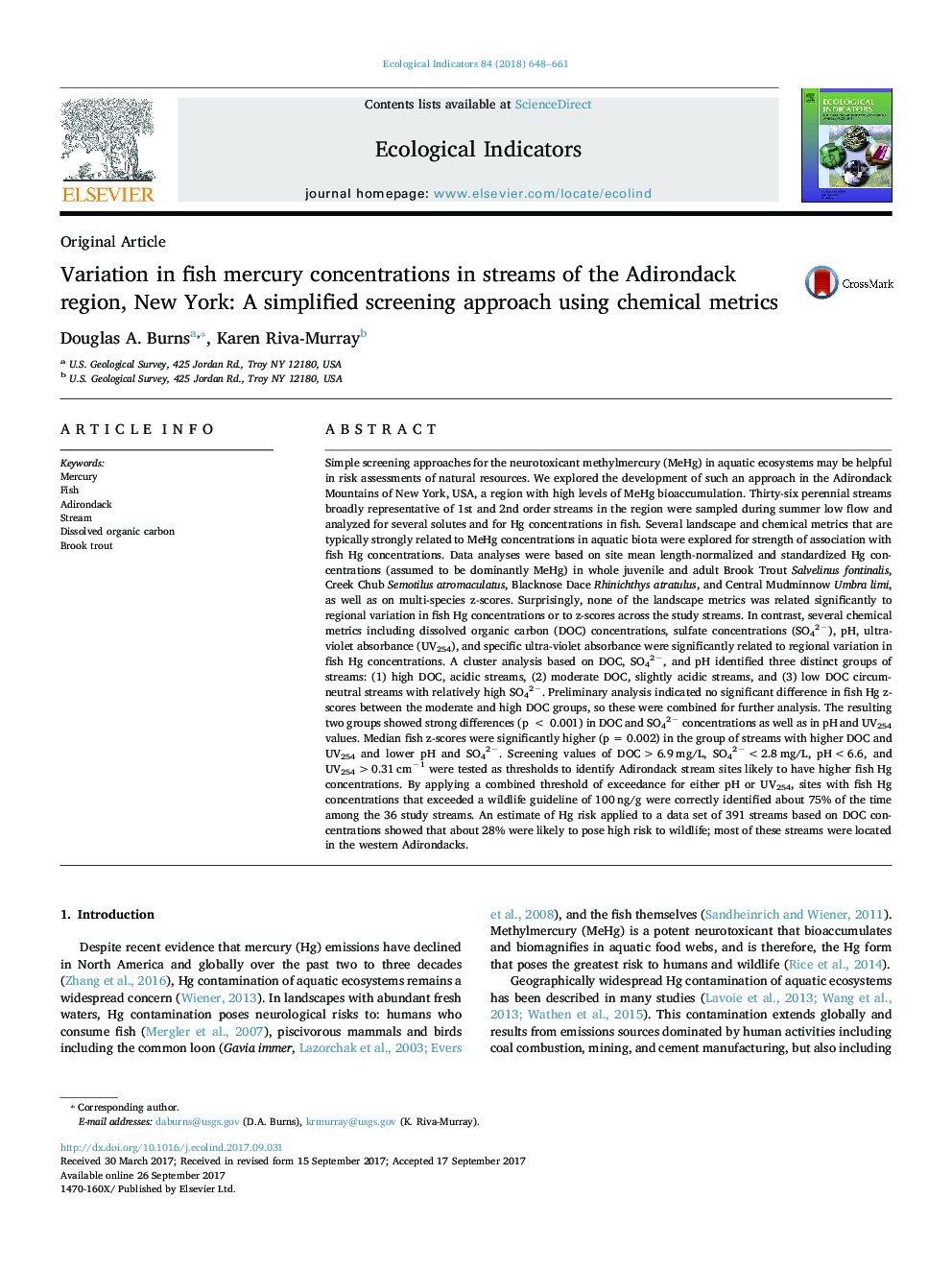| کد مقاله | کد نشریه | سال انتشار | مقاله انگلیسی | نسخه تمام متن |
|---|---|---|---|---|
| 5741587 | 1617118 | 2018 | 14 صفحه PDF | دانلود رایگان |

- Simple screening approach developed for identifying risk of high Hg concentrations in fish based on data collected at 36 Adirondack streams.
- Landscape metrics not useful for identifying risk in streams of the region.
- Several chemical metrics, including DOC, UV254, SO42â, and pH, are good risk indicators.
- About 28% of 391 Adirondack streams likely to have high risk for elevated fish Hg concentrations.
- Most high risk streams located in western part of Adirondack region.
Simple screening approaches for the neurotoxicant methylmercury (MeHg) in aquatic ecosystems may be helpful in risk assessments of natural resources. We explored the development of such an approach in the Adirondack Mountains of New York, USA, a region with high levels of MeHg bioaccumulation. Thirty-six perennial streams broadly representative of 1st and 2nd order streams in the region were sampled during summer low flow and analyzed for several solutes and for Hg concentrations in fish. Several landscape and chemical metrics that are typically strongly related to MeHg concentrations in aquatic biota were explored for strength of association with fish Hg concentrations. Data analyses were based on site mean length-normalized and standardized Hg concentrations (assumed to be dominantly MeHg) in whole juvenile and adult Brook Trout Salvelinus fontinalis, Creek Chub Semotilus atromaculatus, Blacknose Dace Rhinichthys atratulus, and Central Mudminnow Umbra limi, as well as on multi-species z-scores. Surprisingly, none of the landscape metrics was related significantly to regional variation in fish Hg concentrations or to z-scores across the study streams. In contrast, several chemical metrics including dissolved organic carbon (DOC) concentrations, sulfate concentrations (SO42â), pH, ultra-violet absorbance (UV254), and specific ultra-violet absorbance were significantly related to regional variation in fish Hg concentrations. A cluster analysis based on DOC, SO42â, and pH identified three distinct groups of streams: (1) high DOC, acidic streams, (2) moderate DOC, slightly acidic streams, and (3) low DOC circum-neutral streams with relatively high SO42â. Preliminary analysis indicated no significant difference in fish Hg z-scores between the moderate and high DOC groups, so these were combined for further analysis. The resulting two groups showed strong differences (p < 0.001) in DOC and SO42â concentrations as well as in pH and UV254 values. Median fish z-scores were significantly higher (p = 0.002) in the group of streams with higher DOC and UV254 and lower pH and SO42â. Screening values of DOC >6.9 mg/L, SO42â <2.8 mg/L, pH <6.6, and UV254 >0.31 cmâ1 were tested as thresholds to identify Adirondack stream sites likely to have higher fish Hg concentrations. By applying a combined threshold of exceedance for either pH or UV254, sites with fish Hg concentrations that exceeded a wildlife guideline of 100 ng/g were correctly identified about 75% of the time among the 36 study streams. An estimate of Hg risk applied to a data set of 391 streams based on DOC concentrations showed that about 28% were likely to pose high risk to wildlife; most of these streams were located in the western Adirondacks.
Journal: Ecological Indicators - Volume 84, January 2018, Pages 648-661